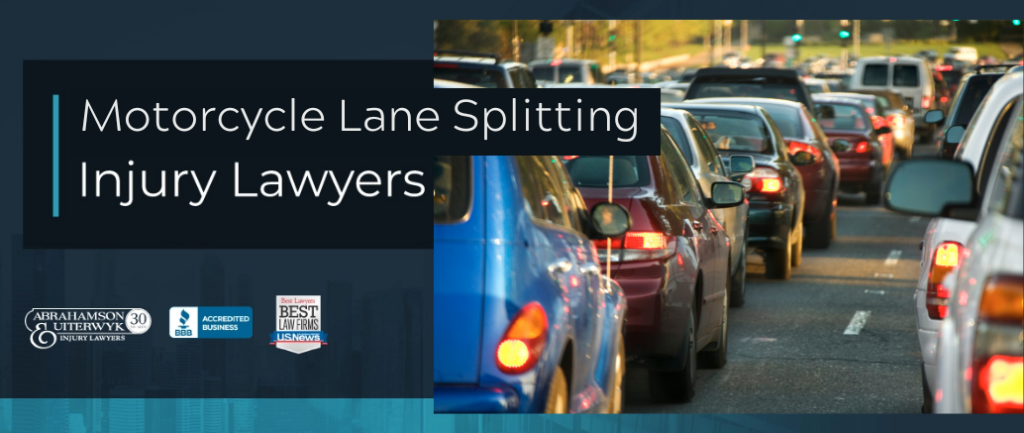Lane splitting isn’t legal in Florida, but we see it every day. Lane splitting is the act of driving a motorcycle in the same lane with another motor vehicle when traffic is crawling or stopped on a freeway. Because of all the dangerous deadly accidents caused by lane splitting, all licensed Florida drivers must be aware of motorcycles sharing their lanes.
The accident attorneys at Abrahamson & Uiterwyk will provide a free case evaluation if you or a loved one has been injured in an accident, call us today, we are available 24/7 at 1-800-538-4878

National Debate
Wrongful death suits for families of deceased motorcyclists are frequently filed in the State of Florida despite the contributory negligence of lane splitting if the cyclist was killed due to the negligence of another motorist. Florida Statute 316.209 explicitly states motorcycles shall not:
- enter, overtake, or pass within the same lane as another vehicle
- drive between adjacent lanes or rows of traffic
- be more than two across on a roadway
Should Florida Make Lane Splitting Legal?
Florida is second to California in the number of registered motorcycles on its highways–over 550,000.
Although it is illegal in Florida to engage in lane splitting, many Florida motorcyclists use this driving maneuver to bypass areas of traffic congestion and sometimes lane split even when it isn’t necessary.
Florida motorists should also be aware of the difference between lane splitting and lane sharing.
While lane splitting involves a motorcyclist driving within the space between two cars moving in the same direction on a highway or interstate, lane sharing is the practice of motorcyclists occupying the same lane. Lane sharing is legal in Florida.
When a motorcyclist is lane splitting in Florida or near Tampa, and causes an accident while lane splitting, they will be doubly ticketed for the accident and for lane splitting.
However, if the Florida lane-splitting motorcyclist can prove the other vehicle driver contributed to an accident in which they were involved (for example, the driver was weaving in and out of traffic or using a cell phone), the motorcyclist may have good reason to sue the vehicle driver for compensation. Learn more on Tampa motorcycle laws.
Advantages and Disadvantages of Lane Splitting in Florida
Proponents of lane splitting claim that it relieves traffic congestion and can improve the comfort of motorcyclists during extreme weather by allowing them to move ahead of vehicles stalled in traffic.
Alternately, opponents of lane splitting say that lane splitting could potentially incite instances of road rage as frustrated drivers watch motorcyclists move freely past them while they are stuck in traffic. In fact, road rage is now among the top causes of vehicle accidents in the U.S.
Interestingly, many cities in California are listed among the top 25 worst U.S. cities for road rage incidences (on a local note, Miami, FL is also included in that list).
Left Turn Accidents
Vehicles turning left cause 42% of all the motorcycle accidents on Florida highways. The motorist almost always blames the cyclist for the accident. Motorcycles are smaller than cars and trucks, and they are frequently lost in their blind spots. Motorcycles don’t reduce impact upon collision like cars and trucks do. Leg amputations and death frequently result from motorcycle accidents involving a motorist turning left.
Fault & Florida Lane Splitting Accidents
The same legal websites and blogs involved in the national debate over the legalization of lane splitting say the vehicle making the left-hand turn is almost always at fault if a collision occurs. Whether lane-splitting was legal when you made your left turn is in the hands of the police officers and at the discretion of the judges. The police officer may look at the damage to the vehicles to determine who was at fault for the accident.
Negligence & Lane Splitting Accidents Near Tampa
The driver of a car or truck making a left turn is negligent if he or she does not yield to traffic traveling straight through the intersection. The driver who turns left must wait until the intersection is clear to turn. Striking a lane-splitting motorcycle while making a left turn is a harrowing experience, but you may be held liable for the motorcyclist’s injuries or wrongful death.
Negligence & Motorcycle Lane Splitting
The driver of a car or truck making a left turn is negligent if he or she does not yield to traffic traveling straight through the intersection. The driver who turns left must wait until the intersection is clear to turn. Striking a lane-splitting motorcycle while making a left turn is a harrowing experience, but you may be held liable for the motorcyclist’s injuries or wrongful death.
Catastrophic Injuries Caused by Lane Splitting Accidents
The Insurance Institute for Highway Safety reports that head injury and brain damage occurs in most fatal motorcycle accidents. Helmets prevent brain injuries in 67 percent of all motorcycle accidents. Collisions with tractor-trailer trucks are especially heinous. A commercial big-rig weighs at least 20 times more than a motorcyclist on a Harley Davidson. Tractor-trailers cannot see what’s in their huge blind spots, and they need at least twice the stopping distance of a car or pickup truck. Yet, motorcyclists split lanes with commercial trucks every day.
Contributory Negligence
Lane splitting places the motorcyclist in the same lane as another motorist who is not expecting to see or may be startled by the motorcycle. A motorcycle in the same lane as a car or a tractor-trailer cannot see the driver’s turn signal. If lane splitting contributed to your motor vehicle accident, the motorcyclist may be liable for the accident. Analysis of contributory negligence can result in reduced recovery of damages or the motorcyclist may be ordered to pay for damage to the vehicle which struck him.
Road Hazards in Florida Lane Splitting Accidents
Road hazards, which simply rattle cars and trucks, can cause lane-splitting motorcycles to slide, fall, or careen out of control. Lane splitting causes accidents especially:
- in wet weather
- around objects dropped on the road
- over uneven road surfaces
- into road construction sites
- with unexpected lane changes
Whether road hazards constitute negligence is up to the judge. Gravel can cause a motorcycle to slide, especially on the curves. Uneven edges of a road can drag a motorcycle out of its lane placing it on the shoulder or in the path of an oncoming vehicle.
Road Maintenance
Expansion and open bridge joints may be open too wide for a motorcycle to traverse and catch a motorcycle tire. Weather affects the expansion and contraction of these usually not noticed joints in the road surface, and a motorcycle is less stable than a four-wheel vehicle. Slicks are totally unpredictable. Slicks occur at any time due to spills, wet leaves, antifreeze, or oil on the road surface.
Is Lane Splitting in Florida Safe?
According to a report by UC Berkeley transportation researchers, lane splitting does not appear to present any greater accident risk to motorcyclists or vehicle drivers than any other traffic maneuver.
Analysis of lane splitting behavior found this practice to be relatively safe when performed in traffic moving no faster than 50 mph by motorcyclists who are not exceeding the speed of other cars by 15 mph or less.
Authors of this report state that it was “the difference in speed between motorcyclists and surrounding traffic that was the primary predictor of injury than just speed alone”.
Data included in the report also evaluated motorcycle-vehicle collisions in California between June, 2012 and August, 2013.
Of almost 6,000 traffic accidents reported by CHiP, 997 involved speeding motorcycles engaged in lane splitting at the time of the accident. However, this data also revealed that lane splitters wore better helmets and were less likely to be intoxicated or carrying a passenger.
Lane Splitting for Florida Motorcyclists
As a Florida motorcyclist, you must always be aware of the vehicles around you. You can wear protective clothing which reflects light. If one lane of traffic is moving faster than the other or only one lane has stopped, vehicles are likely to switch lanes. Beware of blind spots, and only pass at speeds slightly faster than the cars are traveling. Blow your horn if other motorists get too close to you. Duck into your own lane when speed exceeds 30 miles per hour, and remember to drive with your headlight on.
The accident attorneys at Abrahamson & Uiterwyk will provide a free case evaluation if you or a loved one has been injured in an accident. Call us today, we are available 24/7 at 1-800-538-4878.
What Our Happy Client Says About Us On Google
They did an excellent job with my motorcycle accident. Jennifer kept me updated with the progress of the case. Thanks again for handling my case.
Mark K.
⭐⭐⭐⭐⭐
We’re proud of our client’s happiness with our representation by rating us a 4.9 across 314 reviews on Google

